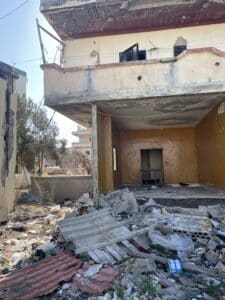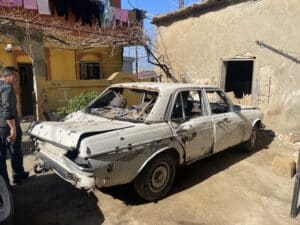Dutch Relief Alliance Joint Response Wraps Up with 66,000+ People Reached
Amid devastation and displacement, Dutch Relief Alliance Joint Response efforts brought critical support to Lebanon’s most affected.
BEIRUT, Lebanon – April 14, 2025

As Lebanon continues to recover from one of the most severe escalations of violence since 2006, the Dutch Relief Alliance Joint Response has wrapped up its coordinated emergency interventions in Lebanon, having reached over 66,000 individuals with life-saving assistance across the country.
From food parcels to mental health and psycho-social support, this collective response — delivered through the efforts of War Child, the lead organisation, six leading humanitarian organisations and over nine locally implementing partners — has aimed to meet the urgent and evolving needs of families displaced or impacted by the conflict, from the North to the South.
Context: A Worsening Crisis
The Dutch Relief Alliance intervention came in response to the escalation that erupted along the Lebanon-Israel border in late September 2024. Tensions had been steadily rising since September 2023, marked by cross-border incidents, sporadic shelling, and growing political instability, which created a volatile environment along the southern frontier and resulted in a ripple effect across the country. Over two months of intense hostilities left thousands of people dead, including hundreds of children, and displaced more than hundreds of thousands — many of whom sought refuge in collective shelters or with host communities across the country. Civilian infrastructure was heavily affected, and public services struggled to cope.

“In response to the dire situation, War Child, together with Joint Response consortium members and partners, mobilised a highly coordinated and complementary effort to deliver critical services across Lebanon. These efforts focused on reaching children, young people, and their families with essential support. The latter included child protection, mental health and psycho-social services, and other life-saving interventions,” said Nisrine Yassine, War Child Lebanon Country Director.
On November 27, 2024 a conditional ceasefire came into effect in Lebanon, offering temporary relief and a window to assess humanitarian needs. For many families, however, the damage was already done: homes lost, health compromised, and lives uprooted.
Coordinated Response Across Sectors
Under the Lebanon Joint Response, Dutch Relief Alliance partners (War Child, Plan International, Oxfam Novib, CARE, World Vision, and Stichting Vluchteling) worked with local implementing organisations to respond rapidly and effectively. Key areas of intervention included:
“Oxfam’s rehabilitation of water stations in heavily affected areas like Nabatieh and Tyre enabled thousands to regain access to clean water, while our coordination with local authorities ensured sustainability and community ownership,” said a representative from Oxfam. “This kind of collaboration across sectors is what made the Joint Response so impactful.”
Local Partnerships: The Power of Collaboration
The response was made possible through trusted local partnerships. Local implementing organisations played a vital role in mobilising outreach and ensuring context-sensitive delivery in areas like Akkar, Baalbek-Hermel, Chouf, Southern Beirut, the South, and beyond.
A particularly striking lesson learned during the response, as articulated by a World Vision representative, was “the importance of flexibility and rapid adaptation, both in terms of geographic focus and sectoral priorities. The conflict dynamics and displacement patterns shifted quickly, and the ability to adjust programming — particularly transitioning from emergency shelter to school rehabilitation — was key to meeting the evolving needs on the ground.”
“The flexibility of the Joint Response allowed us to adapt to shifting realities on the ground,” said a representative from Nusaned, a local implementing partner. “After the ceasefire, shelters we served were emptied almost overnight. We quickly re-scoped and continued distributing hot meals elsewhere, ensuring that no resources went to waste.”
In the Numbers
*According to reports compiled up to March 1, 2025.
A significant portion of those supported were women and children. The commitment to intersectional and inclusive programming was evident across all sectors.
“Working together with local partners allowed us to avoid duplication and respond to real-time community feedback, particularly in collective shelters where the needs shifted quickly,” said a representative from Plan International. “This responsiveness helped us reach over 16,000 individuals with hygiene and Menstrual Hygiene Management kits and distribute thousands of food parcels and winter kits to families in need.”
Looking Ahead
While the ceasefire has offered a temporary reduction in hostilities, the situation remains fragile. Recent escalations in southern Lebanon have renewed concerns about the safety and well being of affected communities. The needs of displaced populations — particularly women, children, and persons with disabilities — are expected to continue well beyond the cessation of active conflict.
The International Refugee Committee, a member of the Joint Response working via Stichting Vluchteling, emphasises the importance of sustained, multi-year funding to address Lebanon’s protracted crises. It recommends investing in national system strengthening — including long-term support to the Ministry of Public Health — and calls for an urgent revision of cash assistance transfer values to reflect rising needs.
Continued, coordinated efforts will be essential to reinforce resilience and ensure that humanitarian assistance reaches those who need it most.
Save the Children
Laan van Nieuw Oost-Indië 131-k
2593 BM Den Haag
The Netherlands
Chair organisation: Plan International
E: office@dutchrelief.org